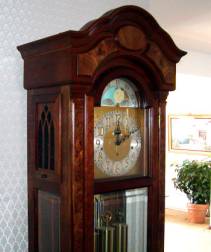| The Grandfather Clock |
During the summer of 2004 St Julie parish
sponsored a series of sessions on "Writing your Memoirs". This
after I had already written 15 chapters of mine. After the first session
Jane Barron gave us a
homework assignment to write about an object. This is my story using her
example as presented the previous week.
Don Plefka |
|
As I descend the
stairs each morning the stately grandfather clock greets me with the
assurance that I am on schedule for the normal routine of the day.
Usually this is a casual and almost subconscious observation, part of
the acquired habit. At other times, as I
sit quietly reading or just reflecting, I become aware
of it as it chimes the quarter hour in its slow deliberate manner. Once
in a while I take a look at the dial that indicates the phases of the
moon although I very seldom check to see if it needs to be adjusted to
match the actual event. The Grandfather
clock is more than a timepiece. It is an elegant piece of furniture with
its dark and highly polished wood finish, decorative curved crown, and
rich burl accents. The beveled glass of its door and the polished brass
pendulum and weights add to the character of this wonderful clock. I call it wonderful
because, in addition to its utilitarian attributes and pleasing
appearance, it tells stories, well, … at least to me. It reminds me of
Dick and Jan, for it was these old friends who caused us to have the
clock. Arriving at their home one day in 1982 for dinner and cards, Dick
proudly introduced us to the clock he had recently built. I was
impressed with his work and determined to build one too. Anne and I went
to the Chicago Clock Company display room at Rout 83 and North Avenue
and after much searching, purchased a kit. It would be larger and more
elegant than our friend’s because … anything Dick could do, I could
do better. That was not true because Dick was always working with
wood, crafting elegant rocking chairs, and other works of art. But the
challenge was to be met. I remember
the unpacking of the wood, all cut to size but in need of final sanding,
and the sheaf of instructions that was intimidating to say the least.
“What had I gotten myself into?” I remember sorting it all out and
gathering the needed tools. Then there were weeks of hand sanding each
piece, assembling by gluing and clamping with the addition of a few
hidden nails and in some cases screws. Assembly of the components was
done in the evening and left to dry overnight. The next evening another
assembly was added to the project. It was done slowly and with
meticulous care. Perfection was the watchword. Then came the time
to apply the finish. This was the part I feared the most and with which
I was the least competent. This is where Anne became my adviser and the
project supervisor. The instructions warned of the fact that the stain
would be absorbed by the burl at a faster rate than the rest of the wood
and so great care was needed. The stain was applied with a nylon
stocking and after an appropriate amount of time (Anne told me when) it
was wiped and allowed to dry. Then it was sanded and another application
made. If it was too light, do it again. If it was too dark … disaster!
Anne let me know when it was just right. And so, the clock still reminds
me that Anne was there to guide me, not just with this project but also
with life. Always apply just enough, not too much and everything will
turn out fine. The next step was
the final assembly when the heavy brass movement was put in place, the
face positioned and the hands installed. The glass was installed and the
doors hung. The chime rods were assembled, the weights hung and the
pendulum suspended. The three weights were cranked to the top and
finally the pendulum given the first push. I still remember the
satisfaction of a project completed and pride in the results. It was
perfect! The grandfather
clock also brings memories of the planning of our new home. It was
during the planning stage that its place was established in the hallway
at the bottom of the stairs. It would be a well-traveled area and
visible from several places. The sound of the chimes would be heard
through out the house and the clock would reside in a place of honor.
The homebuilder was carefully instructed that no electrical outlet,
thermostat or anything else could be on that wall so as to interfere
with the placement of the clock. The grandfather
clock was also an attraction for the grandchildren. If they were to
visit on a Saturday, I would postpone the weekly winding until they
arrived. When they were just old enough, a stool would be provided so
they could reach the handle and wind the mechanism. If more than one
were present they would take turns with each of the three weights to be
wound. Grandma often arbitrated disputes over who should be first. There
would be a great feeling of accomplishment when a stool was no longer
necessary and an even greater celebration when they became tall enough
to reach the key kept on top of the clock.
Our three children have asked which would inherit the clock. At the time I
said I would build two more to resolve the problem. That never happened
and I am afraid that Anne is not here to arbitrate the matter. But,
knowing my kids, I am sure the argument will be … “Oh, no, you
should have it because …” I
am even more proud of my kids than I am of my clock. Can you imagine
that? Grandpa Don
Plefka |
|
 The
clock was as much of the grandchildren’s education as “Please and
Thank You”. They learned that certain things were of value and needed
to be treated with care. They also learned that with time they would be
responsible (and tall) enough to wind the clock without grandpa’s
help.
The
clock was as much of the grandchildren’s education as “Please and
Thank You”. They learned that certain things were of value and needed
to be treated with care. They also learned that with time they would be
responsible (and tall) enough to wind the clock without grandpa’s
help.